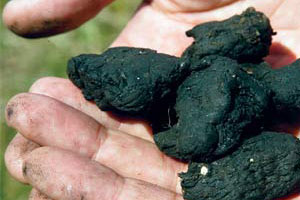
from flick user <a href= "http://www.flickr.com/photos/gtmcknight/1264386424/">gtmcknight</a> under creative commons license
More than half of the 15 trillion gallons of sewage Americans flush annually is processed into sludge that gets spread on farmland, lawns, and home vegetable gardens. In theory, recycling poop is the perfect solution to the one truly unavoidable byproduct of human civilization. But sludge-based as fertilizer can contain anything that goes down the drain—from Prozac flushed down toilets to motor oil hosed from factory floors. That’s why an increasing number of cities have begun to explore an alternative way to dispose of sludge: advanced poop-to-power plants. By one estimate, a single American’s daily sludge output can generate enough electricity to light a 60-watt bulb for more than nine hours. Here are the six most innovative ways that human waste is being converted to watts:
Poop-Eating Bacteria
Digesters similar to brewery casks house anaerobic bacteria that eat sludge and belch out methane. This technology is the oldest, cheapest, and most proven poop-to-power method. Even so, fewer than 10 percent of the nation’s 6,000 public wastewater plants have the digesters; of those, just 20 percent burn the methane gas for energy (the rest simply flare it off). Flint, Michigan, and several other cities use the methane gas to fuel fleets of city buses. The problem with anaerobic digesters is that they only reduce sludge’s volume by half and capture a portion of its embedded energy.
Turd Cell Smashers
Destroying the cell walls in sludge—by heating it under pressure, zapping it with ultrasonic waves, or pulsing it with electric fields—boosts its methane production by 50 percent or more in anaerobic digesters. On the downside, researchers have found that some of these processes can unleash nasty odors and even a “chemical attack” on sewage machinery.
Geological Toilets
Last summer, Los Angeles began injecting sludge into a mile-deep well, where pressure and heat are expected to release enough methane to power 1,000 homes. The well also dissolves and sequesters carbon dioxide that the sludge would normally release, removing the equivalent exhaust of about 1,000 cars per year. “This renewable energy project is absolutely electrifying,” Los Angeles mayor Antonio Villaraigosa told the LA Times. “It will save money and make money.”
Feces Ponds
As a cheaper green option, some 50 waste plants in 20 countries have installed versions of UC Berkeley professor William J. Oswald’s Advanced Integrated Wastewater Pond Systems Technology–large open-air ponds that primarily rely on anaerobic digestion and photosynthesis to break down sludge and convert it into a fertilizer or animal feed of nitrogen-rich algae. The algae in turn can be used as a feedstock for biofuels. Rich Brown, an environmental scientist at the Lawrence Berkeley National Laboratory, sees an obstacle in the ponds’ huge footprint: “For rural areas it’s great,” he says. “For San Francisco it wouldn’t work so well.”
Gassifiers
Sludge gasification plants are popular in Europe and especially Germany. A low-oxygen reaction transforms the solids in sludge into a carbon-rich “char” similar to BBQ briquettes. Next, the char is gasified in the presence of air to produce a syngas that can be burned for energy.
Poop Pyrotechnics
Last year, Atlanta-based EnerTech built the world’s first commercial sludge “pyrolysis” plant in Southern California. Its patented SlurryCarb process converts sludge from a third of Los Angeles and Orange Counties into char pellets that replace coal at a nearby cement kiln; its ash is mixed into the cement.
One Small Poop for Man. . .
With billions in stimulus funds slated for wastewater improvements, is the time right for poop power? Such efforts, which reduce landfilling and emissions, have earned praise from some anti-sludge groups. Caroline Snyder, the founder of Citizens for Sludge-Free Land, calls it a “win-win situation.”
The EPA says sludge power holds promise, but it’s not ready to quit pushing sludge as a wonder fertilizer. This hasn’t deterred the sewage industry, which sees a chance to get into the renewable energy business and put a stop to the stream of health complaints and costly lawsuits. “After almost 40 years of working in biosolids,” a sewage industry official wrote in a recent newsletter. “I never thought I’d say this: it is an exciting time for sludge!”
H/T to the State of Science Report: Energy and Resource Recovery from Sludge, published by the Global Water Research Coalition. Photo from Flickr user gtmcknight used under creative commons license.















